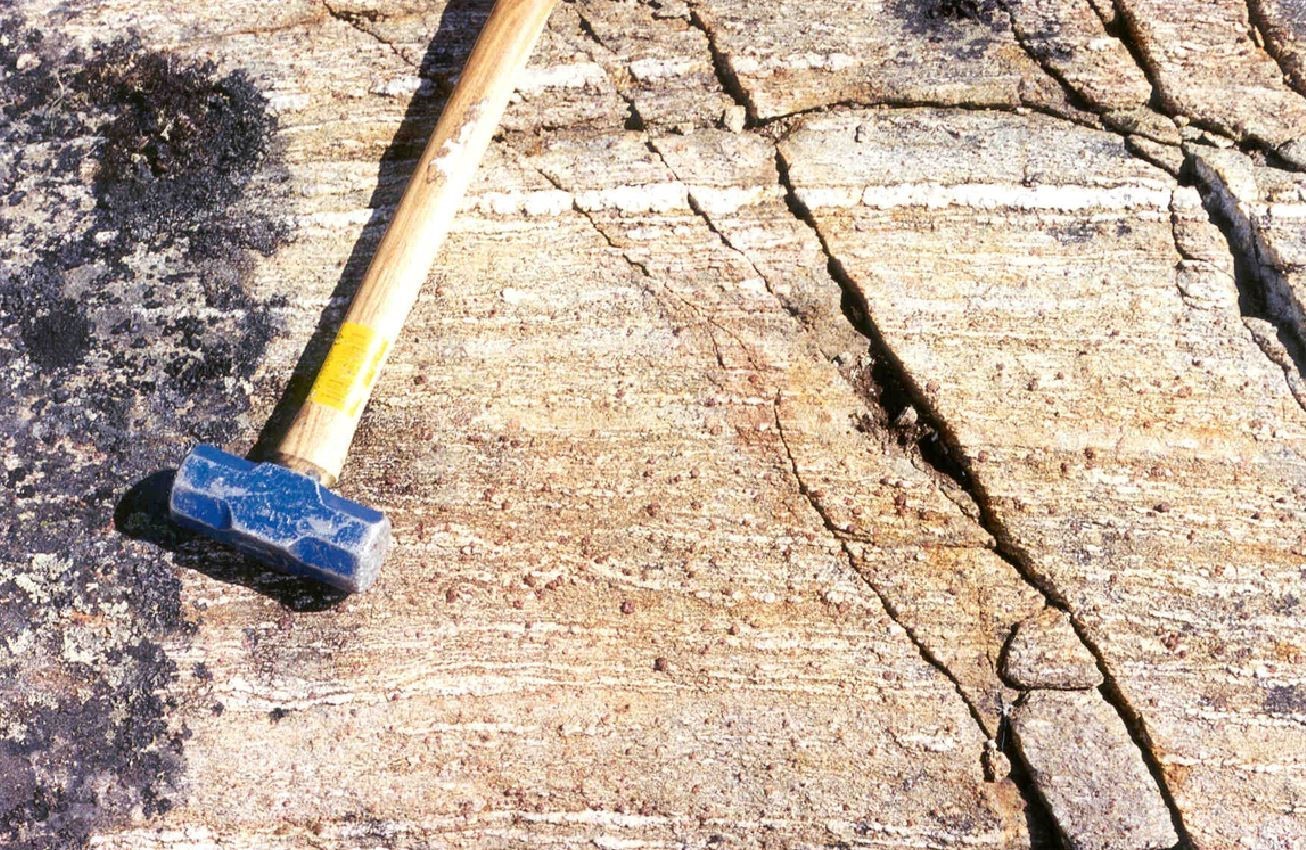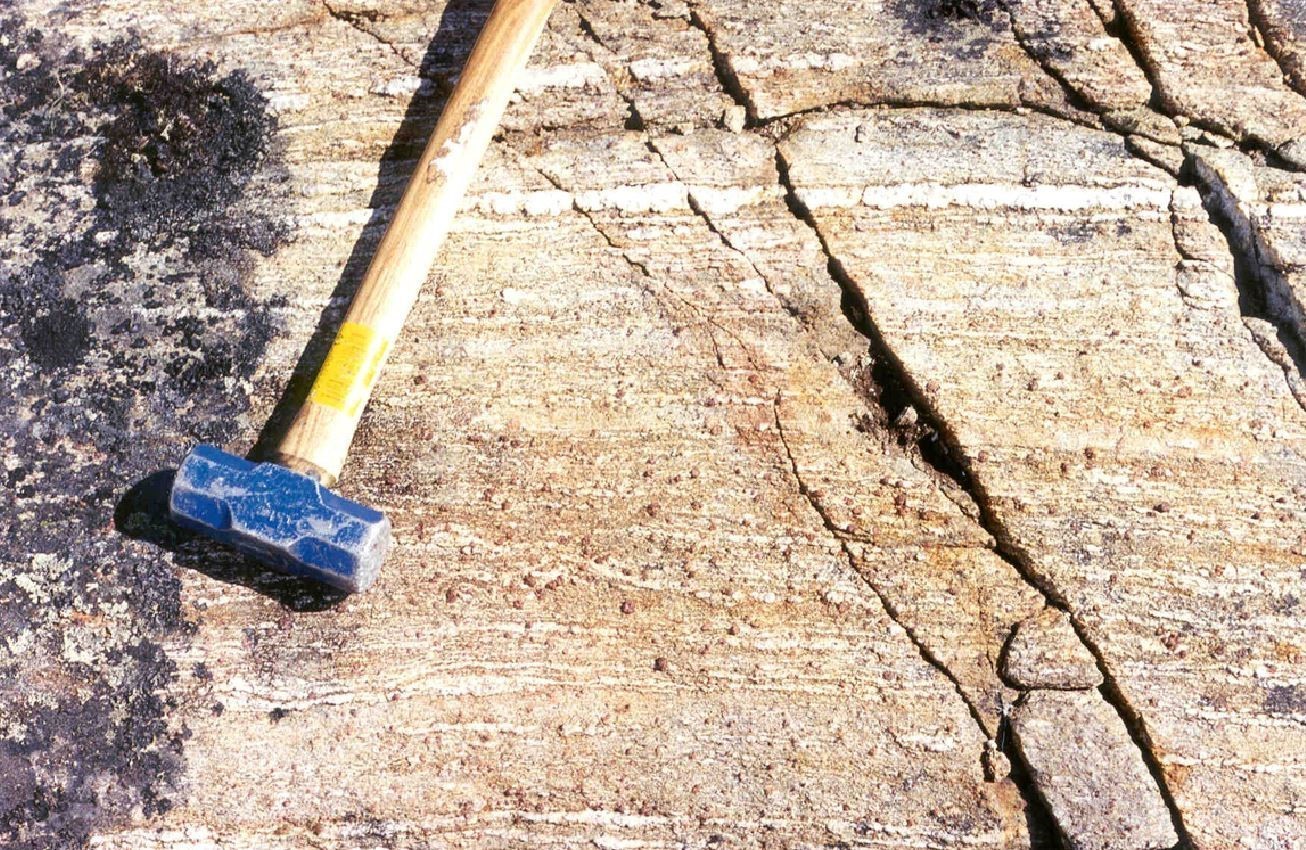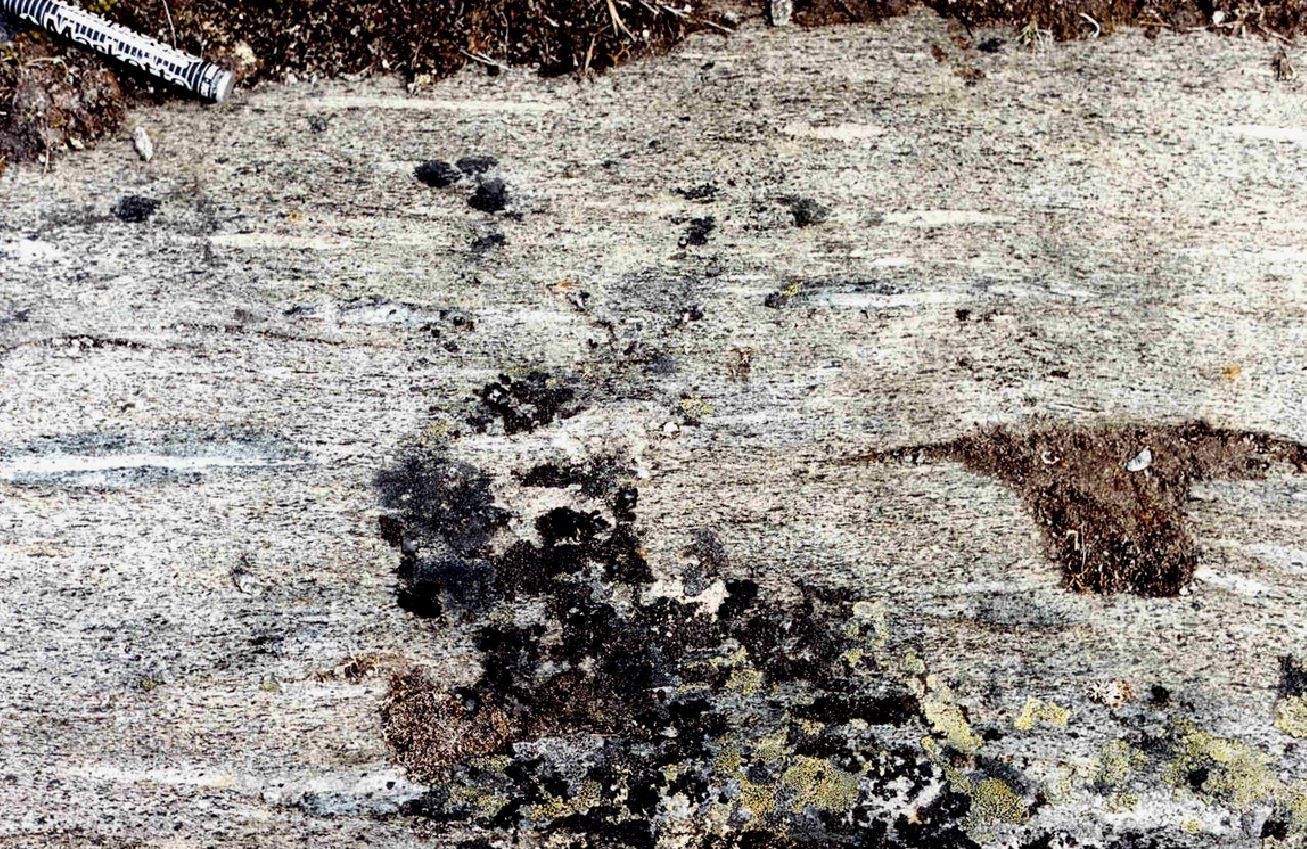
First published: 30 May 2019
Last modified:
DISCLAIMER: This English version is translated from the original French. In case of any discrepancy, the French version shall prevail.
| Author(s): | Simard et al., 2008 |
| Age: | Neoarchean |
| Stratotype: | None |
| Type area: | Pélican Lake area (NTS sheet 34P) |
| Geological province: | Superior Province |
| Geological subdivision: | Minto Subprovince |
| Lithology: | Volcano-sedimentary rocks |
| Category: | Lithodemic |
| Rank: | Complex |
| Status: | Formal |
| Use: | Active |
None
Background
As a result of their reconnaissance work in the Pélican Lake (sheets 34P12 to 34P14) and Bécard Lake (sheet 35A04) area, Percival et al. (1997a) described sequences of paragneiss (Ap), diatexite (Adx) and felsic schist (Afs), and a klippe of rhyolitic to dacitic composition (Ard), which were included in the Pélican-Nantais belt (Percival et al., 1997b). Madore et al. (2001, 2002) introduced the term “Pélican-Nantais Complex” to group these supracrustal rocks during their mapping work in the Klotz Lake (sheet 35A) and Pingualuit Crater area. They subdivided the complex into three informal units: paragneiss (Apna1), metavolcanic rocks (Apna2), and tonalite (Apna3). The Pélican-Nantais Complex was extended southward in the Pélican Lake area (sheet 34P) (Cadieux et al., 2002, 2004). The Nantais belt referred to rocks of the Pélican-Nantais Complex in the Nantais and Klotz lakes area (sheets 35A and 35B; Madore et al., 2001, 2002), while the Pélican belt represented rocks of the same complex in the Pélican Lake area (sheet 34P; Cadieux et al., 2002, 2004).
Simard et al. (2008) divided the Pélican-Nantais Complex into two separate complexes, the Nantais and Pélican complexes, because of the different ages obtained in the Nantais (2775 Ma) and Pélican belts (2740-2733 Ma). They also assigned tonalitic rocks of the Pélican Lake area, originally assigned to the Pélican-Nantais Complex, to a new lithodemic unit, the Itinnaru Pluton, considering their younger age (2691 Ma) than those obtained in rocks of the Pélican Complex (2742-2733 Ma). As a result of these amendments, the term “Pélican-Nantais Complex” was abandoned.
| Actual Unit | Simard (2008) | Simard et al. (2008) | Cadieux et al. (2002, 2004) | Madore et al. (2001, 2002) | Percival et al. (1997a) |
| nApel1 | Apel | Apel |
Apna1 (Pélican belt) |
Apna1 (Nantais belt) | Ap and Adx |
| nApel2 | Apna2 | ||||
| nApel2a | Apna2a | Apna2 | |||
| nApel2b | Apna2b | ||||
| nApel2c | Apna2c | Ard | |||
| nApel2d | Apna2d | Afs | |||
| nAiti (Itinaru Pluton) | Apna3 | Apna3 |
Description
The Pélican Complex consists mainly of paragneiss klippes (Percival, 1997a, b; Madore et al., 2001, 2002; Cadieux et al., 2002, 2004; Simard et al., 2008; Simard 2008). It is divided into two informal units corresponding to units Apna1 and Apna2 of the former Pélican-Nantais Complex in the Pélican Lake area (Cadieux et al., 2002, 2004): the main unit of migmatitic paragneiss, which locally includes diatexite (nApel1), and a unit of associated metavolcanic rocks (nApel2) (MNRF, 2008a,b).
Pélican Complex 1 (nApel1) : Migmatitic Paragneiss, Local Diatexite
Unit nApel1 consists mainly of migmatitic quartzofeldspathic paragneiss. The rock is rusty brown with a schistose texture and compositional banding. It is heterogeneous, leucoratic to mesocratic and coarse grained or, more locally, homogeneous, melanocratic and fine grained. Paragneiss contains centimetric to metric bands of quartzofeldspathic mobilisate (5-50%) containing garnet porphyroblasts. It is composed of quartz, plagioclase, biotite, garnet and locally, cordierite, sillimanite and orthopyroxene. Secondary minerals are magnetite, sulphides, zircon (zoned), muscovite, carbonates, chlorite and, more locally, rutile. Garnet, cordierite and orthopyroxene form porphyroblasts. Garnet is subhedral to anhedral and poikiloblastic; it contains globular to vermicular inclusions of quartz, biotite, plagioclase, cordierite, magnetite and zircon. Cordierite is generally poikilitic, twinned and surrounded by a thin pinnite rim. Biotite is reddish and defines the lepidoblastic texture of the rock. It is usually found rimming other minerals and cutting cordierite.
The unit locally includes diatexite and iron formations. Biotite-garnet diatexite is heterogeneous and medium grained. It contains up to 60% tonalitic to trundhjemitic mobilisate. This mobilisate contains fine-grained to medium-grained melanocratic enclaves, centimetric to decametric and stretched parallel to foliation. Iron formation layers form rust zones, some of which are anomalous in copper, gold, silver, zinc and arsenic. Oxide facies to silicate facies iron formations are generally laminated. The oxide facies is predominant and forms massive magnetite bands. Sulphide mineralization occurs as pyrite, chalcopyrite, sphalerite and arsenopyrite disseminated between magnetite crystals or in millimetric bands parallel to laminations. The silicate facies, much less abundant, is very siliceous and contains little magnetite. The rock is dark grey-green in fresh exposure and rusty brown in altered surface. In thin sections, both facies have a polygonal granoblastic texture. They contain 65-80% quartz <5% plagioclase, 10-15% dark brown biotite in 0.5 mm flakes, ≤5% chloritized hornblende and 10-25% opaque minerals, of which 5-20% sulphides and ~5% magnetite. Both biotite and muscovite mark foliation.
Pélican Complex 2 (nApel2) : Metavolcanic Rocks
Unit nApel2 was divided into four informal units according to the composition of metavolcanics (Cadieux et al., 2002, 2004; MNRF, 2008a).
Pélican Complex 2a (nApel2a) : Foliated Basalt
Basalt (amphibolite or mafic gneiss, nApel2a) forms decametric to kilometric foliated to gneissic layers, more or less continuous, interstratified with paragneiss, intermediate to felsic volcanic rocks and iron formations. The rock is dark green and fine to medium grained. Layers are highly metamorphosed and transposed parallel to regional foliation, locally containing orthopyroxene-plagioclase mobilisate. Basalt also forms decimetric to metric enclaves, angular, elongated parallel to foliation and lenticular in places, within surrounding granitoids. The rock is highly recrystallized and has a homogeneous and nematoblastic or granoblastic texture. It is composed of 40-55% stocky green hornblende and 25-60% plagioclase locally riddled with fine quartz inclusions. Clinopyroxene and orthopyroxene are locally present, and a colourless, twinned amphibole, of the cummingtonite type, was locally observed in trace. Basalt contains 10-15% very fine opaque minerals, disseminated and generally aligned with foliation. These are minimally altered and consist of disseminated pyrrhotite and fine traces of pyrite and chalcopyrite. Magnetite (≤5%) is very fine grained. Epidote is associated with opaque minerals.
Pélican Complex 2b (nApel2b) : Andesite, Block, Lapilli and Crystal Tuff Facies
Andesite (nApel2b) forms kilometre-thick homogeneous strips, foliated to gneissic, or thin layers within mafic volcanic rocks (nApel2a). It is mesocratic, grey to dark grey with a slightly bluish patina, and fine grained. It contains plagioclase phenocrystals (crystal tuff facies), blocks (block and lapilli tuff facies) and locally hornblende porphyroblasts. These rocks contain quartz and the same assemblages of ferromagnesian minerals (hornblende, cummingtonite, epidote) and opaque minerals (pyrrhotite, pyrite, chalcopyrite, magnetite) as basaltic rocks, but in smaller proportions (<40% ferromagnesian minerals, <10% opaque minerals).
Pélican Complex 2c (nApel2c) : Dacite, Rhyodacite
Unit nApel2c includes leucocratic, white to light grey, fine-grained, and highly siliceous felsic rocks. These felsic volcanics form kilometre-thick strips usually in contact with paragneiss (nApel1). They contain either plagioclase (dacite) or quartz (rhyodacite) phenocrystals suggesting crystal, block and lapilli tuff facies. These rocks are foliated and generally display a well-developed lineation. They are composed of quartz, plagioclase, microcline (very locally), biotite and muscovite. Whitish plagioclase (5-15%) forms phenocrystals, microcline is granoblastic and biotite is dark red-brown or greenish and very fine. Up to 25% sillimanite-fibrolite was observed in small clusters stretched near highly epidotitized polycrystalline phenocrystals. Accessory minerals include epidote (pistachite), tourmaline, zircon, allanite, apatite, and very fine and disseminated opaque minerals. Dacite and rhyodacite contain rust zones containing up to 5% disseminated pyrite.
Pélican Complex 2d (nApel2d) : Homogeneous Felsic Schist
Unit nApel2d refers to schistose felsic rocks composed of biotite, plagioclase and quartz with varying amounts of hornblende and garnet. These schists are brownish grey, homogeneous, highly foliated and medium grained. They mark the contact between the porphyritic monzogranite quartz monzonite unit of the La Chevrotière Suite (nAlcv1) and paragneiss (nApel1) or felsic volcaniclastic rocks (nApel2c) of the Pélican Complex east of Pélican Lake.
Thickness and distribution
The Pélican Complex forms a more or less continuous, folded belt that extends over a length of ~80 km in an N-S orientation and a width of <20 km in the Bécard Lake (sheet 35A) and Pélican Lake (sheet 34P) area. Two 5 and 10 km-long klippes extend the complex north to Klotz Lake.
Dating
Pb-Pb ages on zircons of 2739 Ma (David et al., 2009) and 2742 Ma (Percival and Skulski, 2000) were obtained in felsic crystal tuff and rhyolite (quartz-muscovite-biotite schist) from unit nApel2c. Pb-Pb dating on zircons in a mobilisate layer within a migmatitic paragneiss (unit nApel1) yielded a mobilisate crystallization age of 2733 Ma for the external portion of zircons and older ages of 2751, 2758 and ~3095 Ma for the central part of zircons (David et al., 2009).
| Unit | Sample Number | Isotopic System | Mineral | Crystallization Age (Ma) | (+) | (-) | Inherited Age (Ma) | (+) | (-) | Reference(s) |
| nApel1 | 00-AB-157-A | Pb-Pb | Zircon | 2733 | 3 | 3 | 2751 | 4 | 4 | David et al., 2009 |
| 2758 | 7 | 7 | ||||||||
| 3095 | 28 | 28 | ||||||||
| nApel2c | 01-AB-066-A | Pb-Pb | Zircon | 2739 | 4 | 4 | David et al., 2009 | |||
| PBAS-96-63A | Pb-Pb | Zircon | 2742 | 1 | 1 | Percival and Skulski, 2000 |
Stratigraphic Relationship(s)
Supracrustal rocks of the Pélican Complex are bounded to the west by a shear zone and enclosed to the east by late-tectonic intrusions of the La Chevrotière (nAlcv) and MacMahon (nAcmm) suites. Correlations between the Pélican Complex and other supracrustal rocks in the Minto Subprovince are difficult to establish (Simard, 2008). It is possible that some paragneiss klippes contained in the Arnaud Complex, to the east, are equivalent to paragneiss of the Pélican Complex. Simard et al. (2008) associated the Pélican Complex with a calc-alkaline volcanism event accompanied by sedimentation that locally affected the Minto Subprovince between 2740 and 2705 Ma.
Paleontology
Does not apply.
References
Publications Available Through SIGÉOM Examine
CADIEUX, A M., BERCLAZ, A., LABBE, J Y., LACOSTE, P., DAVID, J., SHARMA, K.N.M. 2002. GEOLOGIE DE LA REGION DU LAC PELICAN (34P). MRN. RG 2002-02, 50 pages and 1 plan.
CADIEUX, A M., BERCLAZ, A., LABBE, J Y., LACOSTE, P., DAVID, J., SHARMA, K N M. 2004. GEOLOGY OF THE LAC DU PELICAN AREA (34P). MRNFP. RG 2002-08, 48 pages and 1 plan.
DAVID, J., MAURICE, C., SIMARD, M. 2009. DATATIONS ISOTOPIQUES EFFECTUEES DANS LE NORD-EST DE LA PROVINCE DU SUPERIEUR – TRAVAUX DE 1998, 1999 ET 2000. MRNF. DV 2008-05, 92 pages.
MADORE, L., LARBI, Y., SHARMA, K.N.M., LABBE, J Y., LACOSTE, P., DAVID, J., BROUSSEAU, K., HOCQ, M. 2001. GEOLOGIE DE LA REGION DU LAC KLOTZ (35A) ET DU CRATERE DU NOUVEAU QUEBEC (1/2 SUD DE 35H). MRN. RG 2001-09, 46 pages and 2 plans.
MADORE, L., LARBI, Y., LABBE, J Y., SHARMA, K.N.M., LACOSTE, P., DAVID, J. 2002. GEOLOGIE DE LA REGION DU LAC COUTURE (35B) ET DES LACS NUVILIK (35G, PARTIE SUD). MRN. RG 2002-04, 45 pages and 2 plans.
MRNF 2008a. COMPILATION GEOLOGIQUE 1/250 000, 34P – LAC DU PELICAN. In : MRNF. 2010. CARTE(S) GÉOLOGIQUE(S) DU SIGEOM – feuillet 34p. CG SIGEOM34P, 1 plan.
MRNF 2008b. COMPILATION GEOLOGIQUE 1/250 000, 35A – LAC KLOTZ. In : MRNF. 2010. CARTE(S) GÉOLOGIQUE(S) DU SIGEOM – feuillet 35a. CG SIGEOM35A, 1 plan.
SIMARD, M. 2008. LEXIQUE STRATIGRAPHIQUE DES UNITES ARCHEENNES DU NORD-EST DE LA PROVINCE DU SUPERIEUR. MRNF. DV 2008-03, 107 pages.
SIMARD, M., LABBE, J Y., MAURICE, C., LACOSTE, P., LECLAIR, A., BOILY, M. 2008. SYNTHESE DU NORD-EST DE LA PROVINCE DU SUPERIEUR. MRNF. MM 2008-02, 198 pages and 8 plans.
Other publications
PERCIVAL, J.A., SKULSKI, T. 2000. TECTONOTHERMAL EVOLUTION OF THE NORTHERN MINTO BLOCK, SUPERIOR PROVINCE, QUEBEC, CANADA. The Canadian Mineralogist; volume 38, pages 345-378. https://doi.org/10.2113/gscanmin.38.2.345
PERCIVAL, J.A., SKULSKI, T., NADEAU, L. 1997a. Reconnaissance geology of the Pelican-Nantais Belt, northeastern Superior Province. Geological Survey of Canada, Open File 3525, 1 1:250 000 map. https://doi.org/10.4095/209271
PERCIVAL, J.A., SKULSKI, T., NADEAU, L. 1997b. Granite-greenstone terranes for the northern Minto block, northeastern Quebec: Pelican-Nantais, Faribault-Leridon, and Duquet belts. In: Canadian Shield / Bouclier canadien; Geological Survey of Canada, Current Research 1997-C, pages 211-222. https://doi.org/10.4095/208646
Suggested Citation
Ministère de l’Énergie et des Ressources naturelles (MERN). Pélican Complex. Quebec Stratigraphic Lexicon. https://gq.mines.gouv.qc.ca/lexique-stratigraphique/province-du-superieur/complexe-de-pelican_en [accessed on Day Month Year].
Contributors
|
First publication |
Céline Dupuis, P. Geo., Ph.D. celine.dupuis@mern.gouv.qc.ca (redaction, French and English versions) Mehdi A. Guemache, P. Geo., Ph.D. (coordination); Charles St-Hilaire, GIT, M.Sc. (critical review and editing); André Tremblay (HTML editing). |



